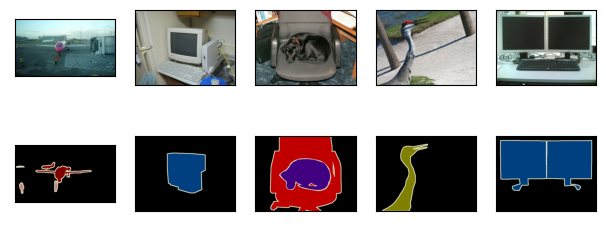在 第 14.3 节-第 14.8 节讨论对象检测任务时,矩形边界框用于标记和预测图像中的对象。本节将讨论语义分割问题,重点关注如何将图像划分为属于不同语义类的区域。与目标检测不同,语义分割在像素级别识别和理解图像中的内容:它对语义区域的标记和预测是在像素级别。 图 14.9.1显示了语义分割中图像的狗、猫和背景的标签。与目标检测相比,语义分割中标记的像素级边界明显更细粒度。
图 14.9.1语义分割中图像的狗、猫和背景的标签。
14.9.1。图像分割和实例分割
计算机视觉领域还有两个与语义分割类似的重要任务,即图像分割和实例分割。我们将如下简要地将它们与语义分割区分开来。
-
图像分割将图像分成几个组成区域。这类问题的方法通常利用图像中像素之间的相关性。它在训练时不需要图像像素的标签信息,也不能保证分割后的区域在预测时具有我们希望得到的语义。以图 14.9.1中的图像 作为输入,图像分割可以将狗分成两个区域:一个覆盖以黑色为主的嘴巴和眼睛,另一个覆盖以黄色为主的身体其余部分。
-
实例分割也称为同时检测和分割。它研究如何识别图像中每个对象实例的像素级区域。与语义分割不同,实例分割不仅需要区分语义,还需要区分不同的对象实例。例如,如果图像中有两只狗,实例分割需要区分一个像素属于这两只狗中的哪一只。
14.9.2。Pascal VOC2012 语义分割数据集
最重要的语义分割数据集之一是Pascal VOC2012。下面,我们将看看这个数据集。
数据集的 tar 文件大约 2 GB,因此下载文件可能需要一段时间。提取的数据集位于 ../data/VOCdevkit/VOC2012.
Downloading ../data/VOCtrainval_11-May-2012.tar from http://d2l-data.s3-accelerate.amazonaws.com/VOCtrainval_11-May-2012.tar...
进入路径后../data/VOCdevkit/VOC2012,我们可以看到数据集的不同组成部分。该ImageSets/Segmentation路径包含指定训练和测试样本的文本文件,而 JPEGImages和SegmentationClass路径分别存储每个示例的输入图像和标签。这里的label也是image格式的,和它的labeled input image大小一样。此外,任何标签图像中具有相同颜色的像素属于同一语义类。下面定义了read_voc_images将所有输入图像和标签读入内存的函数。
#@save
def read_voc_images(voc_dir, is_train=True):
"""Read all VOC feature and label images."""
txt_fname = os.path.join(voc_dir, 'ImageSets', 'Segmentation',
'train.txt' if is_train else 'val.txt')
mode = torchvision.io.image.ImageReadMode.RGB
with open(txt_fname, 'r') as f:
images = f.read().split()
features, labels = [], []
for i, fname in enumerate(images):
features.append(torchvision.io.read_image(os.path.join(
voc_dir, 'JPEGImages', f'{fname}.jpg')))
labels.append(torchvision.io.read_image(os.path.join(
voc_dir, 'SegmentationClass' ,f'{fname}.png'), mode))
return features, labels
train_features, train_labels = read_voc_images(voc_dir, True)
#@save
def read_voc_images(voc_dir, is_train=True):
"""Read all VOC feature and label images."""
txt_fname = os.path.join(voc_dir, 'ImageSets', 'Segmentation',
'train.txt' if is_train else 'val.txt')
with open(txt_fname, 'r') as f:
images = f.read().split()
features, labels = [], []
for i, fname in enumerate(images):
features.append(image.imread(os.path.join(
voc_dir, 'JPEGImages', f'{fname}.jpg')))
labels.append(image.imread(os.path.join(
voc_dir, 'SegmentationClass', f'{fname}.png')))
return features, labels
train_features, train_labels = read_voc_images(voc_dir, True)
我们绘制前五个输入图像及其标签。在标签图像中,白色和黑色分别代表边框和背景,而其他颜色对应不同的类别。

接下来,我们枚举该数据集中所有标签的 RGB 颜色值和类名。
#@save
VOC_COLORMAP = [[0, 0, 0], [128, 0, 0], [0, 128, 0], [128, 128, 0],
[0, 0, 128], [128, 0, 128], [0, 128, 128], [128, 128, 128],
[64, 0, 0], [192, 0, 0], [64, 128, 0], [192, 128, 0],
[64, 0, 128], [192, 0, 128], [64, 128, 128], [192, 128, 128],
[0, 64, 0], [128, 64, 0], [0, 192, 0], [128, 192, 0],
[0, 64, 128]]
#@save
VOC_CLASSES = ['background', 'aeroplane', 'bicycle', 'bird', 'boat',
'bottle', 'bus', 'car', 'cat', 'chair', 'cow',
'diningtable', 'dog', 'horse', 'motorbike', 'person',
'potted plant', 'sheep', 'sofa', 'train', 'tv/monitor']
#@save
VOC_COLORMAP = [[0, 0, 0], [128, 0, 0], [0, 128, 0], [128, 128, 0],
[0, 0, 128], [128, 0, 128], [0, 128, 128], [128, 128, 128],
[64, 0, 0], [192, 0, 0], [64, 128, 0], [192, 128, 0],
[64, 0, 128], [192, 0, 128], [64, 128, 128], [192, 128, 128],
[0, 64, 0], [128, 64, 0], [0, 192, 0], [128, 192, 0],
[0, 64, 128]]
#@save
VOC_CLASSES = ['background', 'aeroplane', 'bicycle', 'bird', 'boat',
'bottle', 'bus', 'car', 'cat', 'chair', 'cow',
'diningtable', 'dog', 'horse', 'motorbike', 'person',
'potted plant', 'sheep', 'sofa', 'train', 'tv/monitor']
使用上面定义的两个常量,我们可以方便地找到标签中每个像素的类索引。我们定义了voc_colormap2label 构建从上述 RGB 颜色值到类索引的映射的函数,以及voc_label_indices将任何 RGB 值映射到此 Pascal VOC2012 数据集中它们的类索引的函数。
#@save
def voc_colormap2label():
"""Build the mapping from RGB to class indices for VOC labels."""
colormap2label = torch.zeros(256 ** 3, dtype=torch.long)
for i







